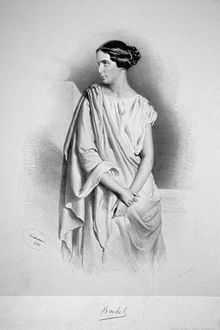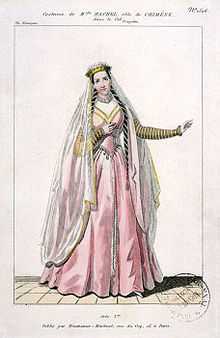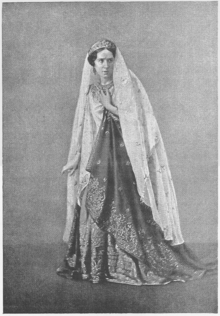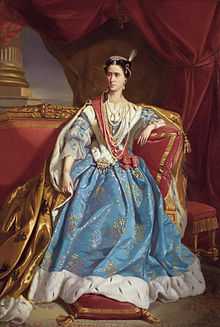Rachel Félix
| Rachel Félix | |
|---|---|
 Portrait of Mlle Rachel by William Etty, 1840s | |
| Born |
Elisa Félix 21 February 1821 Mumpf, Rheinfelden, Aargau, Switzerland |
| Died |
3 January 1858 (aged 36) Le Cannet, France |
Elisabeth "Eliza/Élisa" Rachel Félix (also Elizabeth-Rachel Félix), better known only as Mademoiselle Rachel (February 21, 1821 – January 3, 1858), was a French actress.
Biography
Rachel Félix was born Elisa Félix on February 28, 1821, in Mumpf, Rheinfelden, Aargau. Her father, Jacob Félix, was a peddler and her mother, Esther Hayer, was a Bohemian dealer in second-hand clothes. She had four sisters (Sarah, Rebecca, Dinah, and Leah) and one brother, Raphael.
As a child, Félix earned money singing and reciting in the streets. She arrived in Paris in 1830 intending to become an actress. She took elocution and singing lessons, eventually studying under the instruction of the musician Alexandre-Étienne Choron and Saint-Aulaire. She also took dramatic arts classes at the Conservatoire. She debuted in La Vendéenne in January 1837, at the Théâtre du Gymnase. Delestre-Poirson, the director, gave her the stage name Rachel, which she chose to keep in her private life.
Rachel was described as a very serious and committed student. She was admired for her intelligence, work ethic, diction, and ability to act. Auditioning in March, 1838, she starred in Pierre Corneille's Horace at the Théâtre-Français at the age of 17. During this time she also began a liaison with Louis Véron, the former director of the Paris Opera, which became the subject of much gossip.[1] From 1838 to 1842, she lived in a third-floor apartment in Paris's Galerie Véro-Dodat.[2]
Her fame spread throughout Europe after success in London in 1841, and she was often associated with the works of Racine, Voltaire, and Corneille.[3] She toured Brussels, Berlin, and St. Petersburg. Though French classical tragedy was no longer popular at the time Rachel entered the stage of Comédie-Française, she remained true to her classical roots, arousing audiences with a craving for the tragic style of writers like Corneille, Racine and Molière. She created the title role in Eugène Scribe's Adrienne Lecouvreur. Her acting style was characterized by clear diction and economy of gesture; she evoked a high demand for classical tragedy to remain on the stage. This represented a major change from the exaggerated style of those days, as society was beginning to demand the highly emotional, realistic, instinctual acting styles of the Romantics. Félix completely rejected the Romantic Drama movement happening in nineteenth-century France. She was best known for her portrayal of the title role in Phèdre. Eliza Rachel, as the actress was also known, was reportedly a great tragedienne.

She became the mistress of Napoleon I's son, Alexandre Joseph Count Colonna-Walewski, and together they had a son, Alexandre Colonna-Walewski, in 1844. He entered the diplomatic service and died at his post in Turin in 1898. After an affair with Arthur Bertrand, Félix left for England. There she briefly had an affair with Louis Napoleon Bonaparte, later Napoleon III, as well as with Napoléon Joseph Charles Paul Bonaparte. Her second son, Gabriel-Victor Félix, was never acknowledged by Bertrand. He became a navy man and died in the Congo in 1889.
Rachel never married, although she had many lovers. When Walewski upbraided her for not remaining faithful to him, she retorted, "I am as I am; I prefer renters to owners."
Her health declined after a long tour of Russia. She died of tuberculosis in Le Cannet, Alpes-Maritimes, France. Upon her deathbed, Rachel wrote many farewell letters to her sons, family members, lovers, colleagues and theatre connections at Comédie-Française. A villa in Cannet near Cannes was prepared for her and she died there. She is buried in a mausoleum in the Jewish part of Père Lachaise Cemetery and Avenue Rachel in Paris was named after her. The English theatre critic James Agate published a biography of her in 1928, which echoes the anti-Semitism of his day.[1] A modern account of her life and legacy by Rachel Brownstein was published in 1995.[4]
The character Vashti in Charlotte Brontë's novel Villette was based on Félix, whom Brontë had seen perform in London.
Rachel, a light tannish colour, primarily for face-powder used in artificial light, is named after her; the raschel knitting-machine is according to the OED also named after her.[5]
Chronological repertoire
- 1837:
- La Vendéenne by Paul Duport (Théâtre du Gymnase, 24 April)
- Le Mariage de raison de Scribe et Varner (Théâtre du Gymnase, 12 June)
At the Théâtre Français:
- 1838:
- Camille in Horace by Corneille (12 June to 11 September)
- Émilie in Cinna by Corneille (27 September)
- Hermione in Andromaque by Racine (4 September)
- Aménaïde in Trancrède by Voltaire
- Ériphile in Iphigénie en Aulide by Racine
- Monime in Mithridate by Racine
- Roxane in Bajazet by Racine (23 November)
- 1839:

- 1840:
- 1841:
- 1842:
- Chimène in Le Cid by Corneille (19 January)
- The title role of Ariane by Thomas Corneille (7 May)
- Toured in England and Belgium (summer)
- Frédégonde in Frédégonde et Brunehaut by Lemercier (5 November)
- 1843:
- 1844:
- The title role of Bérénice by Racine (6 January)
- Isabelle in Don Sanche d'Aragon by Corneille (17 January)
- The title role of Catherine II by Romand (25 May)
- Marinette in Le Dépit amoureux by Molière (1 July)
- Toured in Belgium (summer)
- Birth of her son Alexandre in Marly-le-Roi (3 November)

- 1845:
- 1846:
- Toured in the Netherlands, in Liège and in Lille (June)
- Toured in London (July–August)
- 1847:
- La Muse sérieuse in L'Ombre by Molière (15 January)
- Fatine in Le Vieux by La Montagne (6 February)
- The title role of Athalie by Racine (5 March)
- Toured in London, in the Netherlands, and at Liège (May–June)

- 1848:
- Birth of her second son, Gabriel, at Neuilly-sur-Seine (26 January)
- Horace (13 March)
- Toured in Amsterdam (June–October)
- Britannicus by Racine (October)
- 1849:
- Andromaque (January)
- The title role of Le Moineau de Lesbie by Armand Barthet (22 March)
- The title role of Adrienne Lecouvreur (14 April)
- Toured in west and southwest France (29 May - 31 August)
- 1850:
- The title role of Mademoiselle de Belle-Isle by Alexandre Dumas, père(25 January)
- Thisbé in Angelo by Victor Hugo (18 May)
- Lydie in Horace et Lydie by François Ponsard (19 June)
- Toured in London, Hamburg, Berlin, Potsdam, Bremen, Vienna and Munich (July–October)
- 1851: Toured
- 1853: Toured
- 1854: Toured in Warsaw, Saint Petersburg and Moscow (January–April)
- 1855: Toured in New York and in the United States (September–December)
- The troupe separated in Cuba in December.
- 1858: Rachel died on 3 January
Notes
- ↑ 1.0 1.1 Agate, James, Rachel. Gerald Howe, London; Viking Press, NY; 1928.
- ↑ Arnold, Beth. "On Location, Galerie Vero-Dodat". Letter From Paris.
- ↑ George William Curtis (1894). "Rachel". Literary and Social Essays. New York: Harper & Brothers. pp. 97–125.
- ↑ Brownstein, Rachel M., Tragic Muse: Rachel of the Comédie-Française. Duke University Press, Durham and London; 1995.
- ↑ Oxford English Dictionary, OED2 on CD-ROM v 1.02. Oxford University Press, 1992.
References
This article relies heavily on the French Wiki article of the same name, from which this was partially translated in May 2006.

- Anonymous. Rachel et la Comédie Française. Brussels, 1842.
- de B---, Madame, Memoirs of Rachel. London, 1858.
- Barthou, Louis, Rachel. (Acteurs et Actrices d’Autrefois.). Paris, 1926.
- Brownstein, Rachel, Tragic Muse: Rachel of the Comédie-Française. Duke University Press, 1995.
- Coquatrix, Emile, Rachel à Rouen. Rouen, 1840.
- Faucigny-Lucinge, Rachel et son Temps. Paris, 1910.
- Fleischmann, Hector, Rachel Intime: d’après ses lettres d’amour et des documents nouveau. Paris, 1910.
- Gautier, Théophile, L’Art Dramatique en France depuis vingt-cinq ans. Six Volumes. Paris, 1859.
- Gribble, Francis H.,Rachel: her Stage Life and her Real Life. London, 1911.
- d’Heylli, Georges, Journal Intime de la Comédie Française (1852–1871). Paris, 1878.
- d’Heylli, Georges, Rachel d’Après sa Correspondance. Paris, 1882.
- d’Heylli, Georges, Rachel et la Ristori. Paris, 1902.
- Houssaye, Arsène, Les Confessions: souvenirs d’un demi-siècle. Four Volumes. Paris, 1885.
- Janin, Jules, Rachel et la Tragédie. Paris, 1861.
- Kennard, Mrs. Arthur, Rachel. Eminent Women Series. London, 1885.
- Laplane, Gabriel, Rachel: lettres inédites. Paris, 1947.
- Louvet, A., Mademoiselle Rachel: Etude sur l’Art Dramatique. Paris, 1892.
- Martin, Sir Theodore, K.C.B., Monographs: Garrick, Macready, Rachel, etc.. London, 1906.
- Maurice, Charles, Histoire Anecdotique du Theâtre. Paris, 1856.
- Maurice, Charles. La Vérité-Rachel: examen du talent de la première tragédienne du Théâtre Français. Paris, 1850.
- de Musset, Alfred, Un Souper chez Mademoiselle Rachel– Oeuvres Poshumes. 1839.
- de Saint Amand, Imbert, Madame de Girardin [Delphine Gay], avec des lettres inédites de Lamarine, Châteaubrieand, Mlle Rachel”. Paris, 1876
- Samson, Mme., Rachel et Samson: souvenirs de thèâtre”. Paris, 1898.
- Thomson, Valentine, La Vie Sentimentale de Rachel d’aprè des lettres inédites. Paris, 1900.
- Veron, Louis, Mémoires d’un Bourgeois de Paris. Five Volumes. Paris, 1856
 Wood, James, ed. (1907). "Rachel, Eliza". The Nuttall Encyclopædia. London and New York: Frederick Warne.
Wood, James, ed. (1907). "Rachel, Eliza". The Nuttall Encyclopædia. London and New York: Frederick Warne.- Agate, James. Rachel. London: Gerald Howe 1928; NY: Viking Press 1928; reprint Bronx: Benjamin Bloom, Inc., 1969.
- Brownstein, Rachel M. Tragic Muse. New York: Alfred A. Knopf, 1993.
- Forman, Edward. Historical Dictionary of French Theatre. Lanham: The Scarecrow Press, Inc. 2010.
- Gribble, Francis. Rachel. New York: Benjamin Bloom Inc., 1972.
External links
| Wikimedia Commons has media related to Rachel Félix. |
| Wikisource has the text of a 1905 New International Encyclopedia article about Mlle. Rachel. |
- Bartleby's entry on Rachel
- An Englishman in Paris, by Albert Dresden Vandam (see Chapter VI)
-
 "Rachel". Encyclopædia Britannica (11th ed.). 1911.
"Rachel". Encyclopædia Britannica (11th ed.). 1911.
|